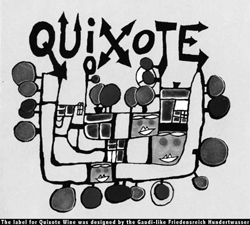![]() By Roy H. Williams
By Roy H. Williams
Brands are extensions of belief systems. You are attracted to a brand when it stands for something you believe in.
 We buy what we buy – most of it, anyway – 1) to remind ourselves and 2) tell the world around us, who we are.
We buy what we buy – most of it, anyway – 1) to remind ourselves and 2) tell the world around us, who we are.
Brands are identity reinforcement, just like art and architecture and music. Brands are a way of shouting “This is me!”
Does it make you uncomfortable for me to suggest that we are such shallow and uncertain creatures that we feel the need to anchor our identities through purchases and acquisitions?
I’m sorry. I’ll change the subject.
Let’s talk about art.
Art is a language. When you control the art in a room, you lead its viewers to where you want them to go in their minds.
Have you ever noticed the high percentage of wall posters that celebrate cultural icons? Marilyn Monroe, The Statue of Liberty, Jimi Hendrix, Corvette.
Cultural icons are modern archetypes. Each of them stands for something we believe in. They’re just another way of shouting, “This is what I believe in! This is me.”
But art communicates a belief system even when it contains no cultural icon.
A painting of cows grazing contentedly on a hillside, or of small fishing boats floating quietly offshore whispers to the viewer, “I believe in tranquility, nature, and the outdoors.”
A painting of Renaissance royalty or of a castle on a mountaintop says, “I believe in pageantry and romance and I’m intrigued by the grand adventure of privilege.”
A painting of young girls frolicking at a picnic says, “I believe in innocence and happiness and the togetherness of friendship.”
The same person could own all three paintings, of course. Each of us wears many faces.
Art is easy to sell when you understand that it’s never really about the artist, (although the artist often believes otherwise.) Art is ultimately about the person who buys it.
You buy art when it looks you directly in the eye and says, “I echo something important that you hide in your heart. I am an extension of the real you.”
Richard Grosbard, Richard Minsky and I were looking for a cab in Manhattan one night when Minsky muttered something so insightful that I scribbled it on the back of a receipt in my wallet:
“Art has image, metaphor and surface.
Image: What’s it a picture of?
Metaphor: What does the picture stand for? What does it mean?
Surface: What materials were used and how skillful was the artist’s execution?”
“Decorative art is image first, metaphor second, and the surface doesn’t really matter. A poster is the same image and metaphor as the original painting but the surface is different.”
“Fine art is surface first, metaphor second, and the image doesn’t really matter. Fine art is all about the skill of execution. It doesn’t really matter too much what it’s a picture of.”
The thing Richard said next is something every artist needs to know if they want to sell a lot of art:
“Commercial art is metaphor first: what does it say? Image second: what’s in the picture? Get these two things right and the skill of the artist doesn’t really matter.”
Most of us buy art because we believe in what the art says.
But then again, that’s what I was saying about brands, isn’t it?
We seem to have gone full circle and now we’re back to where we started. I think I’ll jump off this merry-go-round and go see what Pennie is doing.
Ciao for Niao,
Roy H. Williams
“I am irresistible, I say, as I put on my designer fragrance. I am a merchant banker, I say, as I climb out of my BMW. I am a juvenile lout, I say, as I down a glass of extra strong lager. I am handsome, I say, as I don my Levi’s jeans.” - John Kay
♦

